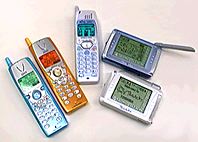STELLAR CELLULARS:
New Mobile Phones Make Fashion Statement
March 11, 1999

Mobile phones are now available in a variety of designs and functions, including those that allow users to send pictures they drew on the screen (right).
Have you ever seen a leopard-spotted cellular phone? Or one that plays movie theme songs to signal incoming calls? In Japan, where approximately one in three people own a mobile phone, these have become common sights and sounds. Today's mobile phones are more than just communication devices: They have become indispensable tools of everyday use offering a multitude of functions like text transmission and information downloading. Perhaps as an indication of users' growing attachment to these devices, the number of people looking to customize the appearance and sound of their phones is also on the increase.
The Rise of the Cellular
Cellular use took off in 1994 after the phones, previously available only on a rental basis, began to be offered for sale. Service providers, desperate to enlist new customers, dropped prices for the units to attractive levels--in some cases the phones were even given away free. Many firms began waiving sign-up fees as well in 1996, and service fees were also slashed, making it affordable for anyone to own and use a mobile phone. Within a couple of years the phones, once an expensive luxury item, found themselves in the hands of everyone from business workers to homemakers to high school students.
Can't Live Without Them
Today the phones come equipped with an increasingly broad range of functions and services. As a result, they are becoming more and more indispensable. Most popular among these right now is "mobile mail," which started catching on in the latter half of 1998. This function allows the user to send and receive text messages of up to 1,500 Japanese characters through the phones. One service company reports that some 40% of its calls are mobile-mail transmissions.
As an offshoot to the popularity of cellular e-mail, mobile devices with large display panels designed to be used exclusively for sending and receiving electronic mail messages have begun to appear on the market and are growing in popularity, especially among young people.
Another commonly used service allows users to receive textual information, such as weather reports, news headlines, and even ski snow reports, and display it directly on their cellular terminals' display panels.
Vehicles for Self-Expression
The evolution of cellulars is not just limited to what these devices can do. More and more owners are customizing their phones' body and sound, turning cellulars into an avenue for self-expression.
Since last year, the programming of melodies of the latest hit songs in place of a standard ring signal has become the rage. One freelance writer suggests that young people first began programming these melodies in order to surprise friends and innocent bystanders with unexpected sounds. The trend soon spread among business users. There is a reported case of one businessman's phone ringing in the middle of a meeting, surprising the gatherers with the melody of the theme from the movie Rocky. Through the end of 1998 there were some 10 how-to manuals and song books on the market offering detailed instructions on programming melodies. There is also a popular Web site that makes it easy for users to create tunes on their personal computers.
In response to this trend, newer cell-phone models, which originally were limited to quarter notes and no more than a 30-note input capacity, now allow the programming of up to 128 notes, including sixteenth notes, in a three-octave range.
The most recent fad is to decorate the exteriors of the cellulars with original designs. The phones, most of which have traditionally been offered only in monotone colors, are now available in a variety of designs, such as zebra or tiger stripes or flower patterns like hibiscus.
From an ever-blossoming multitude of functions to their attention-grabbing sounds and designs, cellular phones are now much more than just tools for communication. They have become fashionable, do-it-all, super devices.
 Edited
by Japan Echo Inc. based on domestic Japanese news sources. Articles presented
here are offered for reference purposes and do not necessarily represent
the policy or views of the Japanese Government.
| 


















